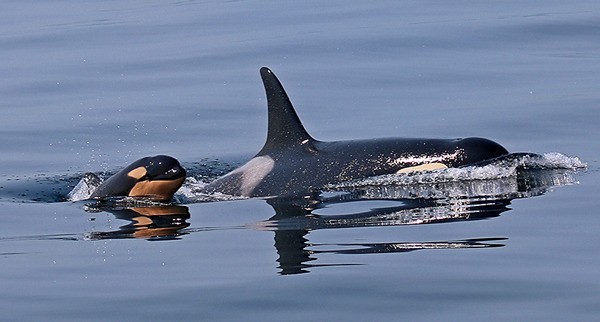Only seven weeks after its celebrated arrival, the first newborn in nearly two years to join the population of endangered killer whales that makes their summer, seasonal home in the San Juans is now missing, and presumed dead.
The Center for Whale Research confirmed that the baby, L-120, first identified Sept. 6 off the west side of San Juan Island, was nowhere to be seen when its mother, L-86, along with other members of L-pod, were recently photographed in the waters of Juan de Fuca Strait.
“L-86 was seen and photographed on Friday, Saturday and Monday, all without L-120,” Center for Whale Research Ken Balcomb said.
Balcomb maintains the disappearance of another calf and the absence of newborns underscores the plight of the orcas, whose numbers continue to plummet. The decline coincides with the once-abundant salmon runs off the Pacific Northwest and Canada, Chinook in particular, the primary source of prey of the resident whales, dwindle to historic lows.
The population, 78 whales in all, is at a 30-year low.
“Thirty years ago, there were anywhere between three to nine babies each year,” he said.
An abundant food source is critical for survival of a newborn killer whale, as calves nurse on its mother’s milk for about a year, Balcomb said.
Listed endangered in the U.S. in 2005, the southern residents consist of three tightly knit clans, known as J, K and L pods. The population was afforded protection under federal law in the footsteps of a 20 percent decline in the mid 1990s. As of 2010, the population totaled 87 animals. The southern Residents are designated endangered by Washington state and in Canada as well.
L-120 was the first addition to the Southern Resident orcas since August, 2012, the third calf of L-86, a 23-year-old female. L-86 is also mother of a 10-year-old male, L-106, and its second offspring, L-112, also known as Sooke, died in early 2012 of injuries to tissues in its skull resulting from a massive pressure trauma of an unknown cause.
The death L-112, an otherwise healthy 3-year-old, led to a high-profile necropsy and speculation among many that its injuries may have been caused by ammunition training off the coast of Washington state by the U.S. or Canadian Navy, near the mouth of Juan de Fuca Strait. Donated to the Friday Harbor Whale Museum, the skeleton of L-112 remains on display.
“We haven’t treated these magnificent orcas well at all,” Orca Network’s Howard Garrett said in the wake of L-120’s disappearance. “As a society we are not successfully restoring this orca community despite the many warnings and legal declarations.”
Co-director of the Whidbey Island-based marine mammal advocacy group, Garrett said the Salish Sea’s resident orcas will likely vanish in the coming years unless the region’s salmon runs, the killer whales primary source of sustenance, are restored and protected.




